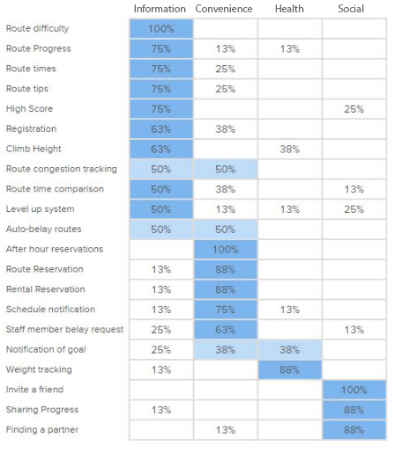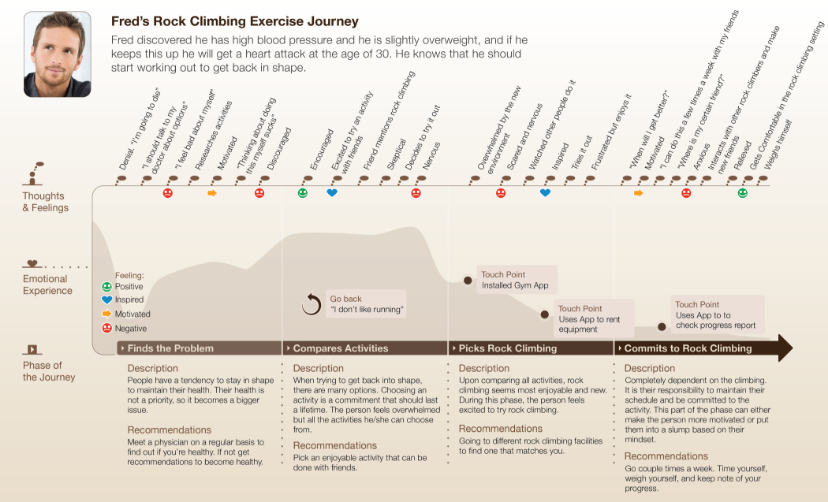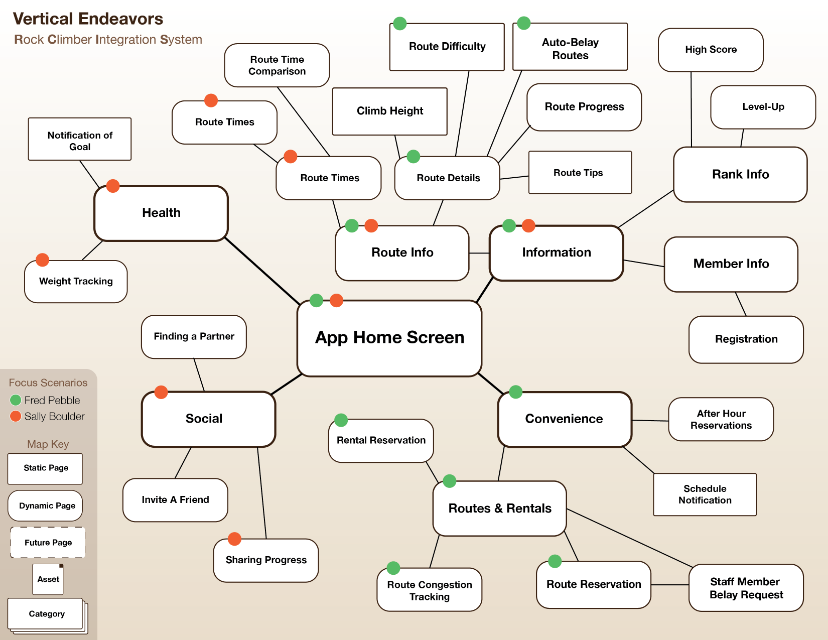Vertical Endeavors
Vertical Endeavors
App Conceptual Design
This is a graduate school project looking into how to improve the user experience of climbing gyms using interactive technology and mobile devices. The focus is on conceptual design (observation, research, conceptual analysis, ideation), the elements that provide the foundation for developing the mobile application (wireframe, prototype, user test, iteration, engineering, art).
What is the system name?
Vertical Endeavors - Rock Climber Integration System
Who are the system users?
All indoor climbers (boulder and rope), encompassing all skill ranges
What will the system do?
Allow users to register for Vertical Endeavor’s rock climbing gym on their mobile phones. The system tracks the amount of time on wall, weight, and performance of the climber via a simple tracking wristband
What problem(s) will the system solve?
The main problems the system solves are member congestion, rental equipment delays, and user’s health tracking
What is the design vision and what are the emotional impact goals / What experience will the system provide to the user?
The emotional impact goals are to simplify the users setup to the climbing experience and to improve health and fitness goals. While enjoying their climbs with friends or alone, they can monitor their health and progress. This builds the user’s confidence through working out and motivates them to be committed to the task with reports and notifications from the app.
This system also brings competition into the picture by integrating high scores. The high scores are key goals for some rock climbers, and once achieved they feel accomplished and satisfied with themselves. The visual graphs that the system records for the user’s weight will also bring satisfaction, motivation, and confidence as they progress and lose weight.
Casual Climber:
Before Visiting the Gym
The casual rock climber has free time today and decides to go rock climbing. He / she decides to go to Vertical Endeavors with friends. They use the app and check the auto belay routes, which are not busy, becuase their friends do not have belay experience. Not wanting to go through the hassle of waiting in line for rental equipment, they reserve ahead of time through the app. When the they reach the gym, the service rep will scan the code and provide the locker number and passcode containing their equipment.
During Their Gym Visit
Once at the gym they head over to the least congested route with auto belays. Right away they notice that the app tracks how many routes they have been on and the time of the climb which starts a friendly competition. The casual climber scans the route QR code, which provides tips and warnings. They compare data on their app for friendly competition.
After Visiting the Gym
Once finished climbing, they share their route data with friends (using social networks), encouraging them to join next time. They also look at their climbing data, and see some improvements since they started rock climbing. They also notice their weight has decreased after weeks of visits to the climbing gym.
Active Climber:
Before Visiting the Gym
The active rock-climber decides to go to Vertical Endeavors today and try more challenging belay routes with a friend. They check to see if the wall has been reset since their last visit. They check member congestion because they don't want to wait for wall time, reserve trackers, and reserve a locker for storing personal belongins securely.
During Their Gym Visit
After gathering their equipment, they arrive at the gym, show their membership cards, check out a wall tracker (attaches to show and wrist) and activate tracking. Their routes are open and they begin climbing. During their visit the app is actively recording the user’s routes climbed, route times, and completions.
After Visiting the Gym
Once finished climbing, they leave the gym and are able to view their current route times and completions. The app offers visuals for historical comparison for improvement monitoring. They are able to compare their data with those of their friends and share their progress through their chosen social media platforms.
Casual Climber Before Their Gym Visit
Persona Name: Fred Pebble
Brief Description:
Fred is not very active but enjoys doing recreational activities with his friends. Fred is trying to get back in shape, and has been told climbing is a fun and calorie burning activity. He calls a couple of his friends to join him in rock climbing. He and his friends aren’t experienced climbers, Fred finds a link to the Vertical Endeavors App on the company website and installs it from the store. He uses the application on his phone and quickly finds beginner routes. After reviewing the app, he sees that some of them are less congested than others and some have auto belays or belay partners. Fred, preferring to stay within his group, chooses the auto belay routes that are least congested. He and his friends do not want to wait in line for equipment, they pre-order the rental equipment through the mobile application. Once they arrive at Vertical Endeavors, they see that their route is clear and their rentals are prepared.
Reasoning:
Casual climbers do not go to the rock climbing gym often, it is harder for them to know which route is best for their level. In this case, Fred does not go rock climbing that often and it’s more considered a recreational activity as opposed to a work out commitment. This makes Fred a perfect candidate as a casual climber being that they have a harder time before the rock climbing interaction. The team decided that the research / before section would describe the situation a casual climber will encounter when they want to rock climb.
Active Climber After Their Gym Visit
Persona Name: Sally Boulder
Brief Description:
Sally tries to visit the rock climbing gym three days a week after work to stay healthy and improve her technique. Her overall goal is to be able to go on a rock climbing trip to Yosemite with some of her friends. After each visit to the gym she is excited to check her progress and verifies that she is within her target weight range. On the bus home she opens the app and takes a quick look at the weight chart and then checks her route performance by comparing her current route times and completions to her previous. She sees that she has improved quite a bit on a challenging route (specific v-rating category) and decides to share her results with her friends on Facebook to keep the excitement going about their planned trip.
Reason:
Active climbers are more focused on their overall performance which they are able to look at more effectively after their climb. Their pre-visit and during-visit activities rely on the app less than when they leave the gym. Sally is a good example of this. During the climb she wants to focus on the climb itself leaving the data review for after her visit. She also is planning a climbing trip with friends which makes the sharing features highly useful.
Wrist band token - Timer
Reason: The wrist token keeps track of the time taken on the route which is what a timer would do in real life. The advantage of this metaphor is that the result of timing with a timer and the shoe tracker are the same. The disadvantage is that using a timer is a manual process while the shoe tracker is able to track route times automatically, including completion data.
Check route congestion - Traffic Report
Reason: A traffic report shows whether a route is congested from an accident or too many cars. The advantage is that people can easily relate to what a traffic jam looks like, and so they would want to avoid such times / routes. The same logic applies to rock climbing. However, the disadvantage is that a traffic report is binary (indicates traffic or no traffic) while this rock climbing scenario is not. For example, the congestion could be people waiting in line for equipment, climbers waiting for wall time, errors with routes (broken auto-belay or holds), or if someone was injured (resulting in temporary shut down).
Pre-Order equipment - Food Order Take Out
Reason: It’s an immediate request for something to be reserved and given to the user. You order food, go to the restaurant, and pick it up. In rock climbing, you reserve the equipment, arrive at the facility, and pick up the equipment. The advantage is that the restaurant take out and equipment pre-order have the same progress. You contact, pick up, and go along your way. The disadvantage is that, the equipment rental has to be returned, while take out has to be consumed.
Check progress - Health Progress Journal
Reason: Keeping track of and checking your health progress is similar to looking at and keeping track of your weight manually. The advantage is that many active individuals keep an activity log and frequently compare their current results to previous results. The disadvantage to this comparison is that a journal is much more manual while the app would keep track of your progress based on your wrist token and QR check-ins.
Share progress - Bragging
Reason: If the user decides to brag about the progress they made over the week / month they can share it with their friends through the application. The advantage is that it would motivate and challenge others to participate. The disadvantage would be that the user might not have enough friends to share it with.
Indirect Manipulation (Wrist Token/ QR code)
Reason: The app integrates with the wrist token which times the user on routes based on tags set at the start and end of the route, includng completion status (did the user get to the final hold?). The interaction between the sensors and the device is wireless and visual. Another aspect with physical sensor technology is the QR codes placed at the beginning of the route which allows the user to view tips for it via the app. The disadvantage is that the user needs to carry around a physical object. The advantage is that the user is able to obtain more information about the routes which they climb on.
Direct manipulation (Mobile application interface)
Reason: The application is on a mobile devices that requires touch screen interaction. The information is immediately shown. The advantage of this is that it is intuitive for the user to use and the information displayed is effective, resulting in minimal error. However, some menus could be better navigated with a mouse as opposed to touch (such as short cuts or multiple windows).
Discussion Tools: Optimal Workshop
Selection of Subjects: The subjects ranged from new/casual climbers to more active climbers. These subjects were chosen because they are the target audience that is most inclined to use the application.
Process: We chose the most important components in our application. We chose to do a closed card sort, to limit the number of cards we needed and to see if our categories were intuitive. We prepared our cards using the Optimal Workshop website and selected our participants (8 were chosen). These were remote sorting sessions, we emailed the link to our participants. Each participant was asked to sort the cards in the assigned categories.
Results:







